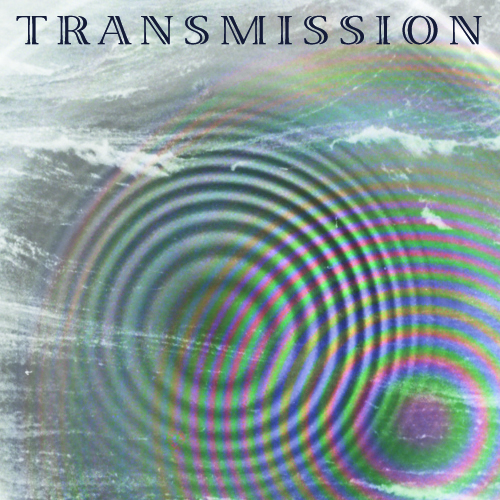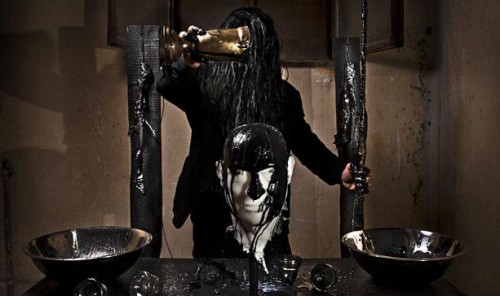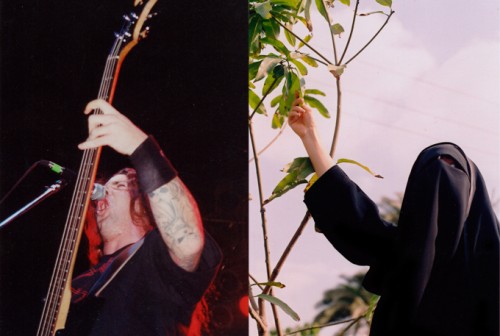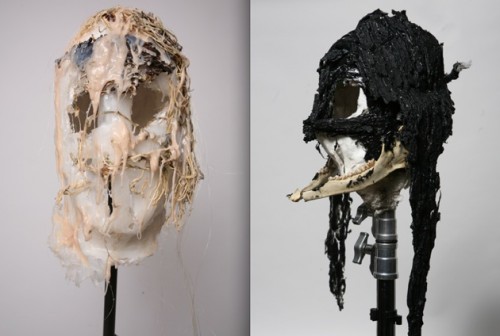Since 2009, conceptual artist Nader Sadek has been directing and producing an epic undertaking. The first phase of this project was the album In the Flesh released in 2011 (the band, a Death Metal supergroup brought together by Nader), the second phase involves videos based on the album’s tracks (of which two are currently available), and the final phase is a type of Metal opera—a magnum opus, if you will—which promises to be a spectacular fusion of art and music including sculptures, installations, and performances.
Born in Cairo, Nader draws upon his direct experience with the use of Metal and art as a form of political protest, which he has written about here. He is currently based in New York City and has established an international reputation in the Metal community for his artistic collaborations with Attila Csihar, which have produced costumes and stage designs.
Previous articles and interviews with Nader conducted by Invisible Oranges, NPR, and Vice have largely focused on his collaborations with iconic Metal musicians (whose mythic careers Nader has also deliberately folded into his concept for the In the Flesh project) and his masks for Attila’s stage performances. Although Nader uses music as a medium, he does not describe himself as a musician. (Nader directed the sound of In the Flesh, but his actual part in writing the compositions was minimal.) Furthermore, his work with Attila is only part of his ongoing mask projects. In order to emphasize and contextualize Nader’s artistic decisions, I’ve decided to focus here on the virtual lexicon that he is building as he infuses objects—such as petroleum, the guitar, hair, and sulpher crystals—with new meanings, values, and ritualistic powers. So, without further ado:
Amelia Ishmael: Could you tell me a little bit about In the Flesh?
Nader Sadek: In general, I created a vocabulary for In the Flesh that links the concept with the songs, and the visual works. Each time I jump from medium to medium, the concepts become more stretched in abstraction: another interpretation of the same thing, like multiple perspectives on a single object. “Wounded flesh” is a metaphor for oil. The origin of petroleum lies in the flesh of everything, from animals to trees that lay dormant inside the earth. Not only is petroleum literally—at one point—living bodies, but in a sense the way petroleum has been commodified is leaving scars of war and pollution on humanity.
[youtube:https://www.youtube.com/watch?v=MB8B40PWZ3A]
AI: “Nigredo In Necromance,” one of the first videos you directed and produced for In the Flesh, opens with a closeup of one of your masks. It then cuts to a shot of a guitarist standing in a lush wooded area, his head banging slowly as he performs the dense composition. So far, this is not too far from what viewers might expect from a Metal music video. But then, the instrument’s body abruptly changes into a fleshy mass, the guitarist is not so much strumming as… fingering this “flesh guitar,” which is now excreting black liquid. Tell us what’s going on here.
ND: Each song has its own theme and a specific sound that goes along with it. “Nigredo…” revolves around a man whose loved one dies. Unable to cope with the loss, he buries himself behind her. And with the spread of bacteria that has grown on her body, extending itself onto him, he starts to rot alive with her. They eventually both decay and reunite as one, in petroleum.
In the video the character, played by myself, documents the preparation of a ritual to bring his lover to ripe decay. The main bassline is played as the start of this ritual. When the harmony comes, it transforms the guitar to “flesh,” implying that it has instigated the conjuration of the petro-theme. The flesh of the guitar gets excited as the character’s hands “masturbate” the guitar, and ultimately it results in the decay of the head, which is then embraced, turning the couple into one entity. The flesh guitar is hence a symbolic object that connects reality to the fantastical and metaphorical worlds created in my artwork.
AI: Petroleum has long had a complicated place in your art. In your 2011 performance “Baptism in Black” this liquid was used to ritualistically banish the power of Egypt’s former president Hosni Mubarak. It seemed, then, as a political critique that drew upon Egypt’s own natural resources (literally with the commodified oil, but then also essentially as a signifier of the stamina of the revolution). But, in “Nigredo In Necromance,” this fluid has, as you’ve mentioned, a much more direct reference to life-force, or sexual energy.
[youtube:https://www.youtube.com/watch?v=c2r6Pa_Hm_4]
In “Sulffer” (another video from In the Flesh) a man stands in a cave, waist-high in this black fluid. It begins as a placid setting and then evolves into a turbulent force that fights against the performer. How does your use of this substance transition through your work?
NS: For each song, I wanted to take the concepts of petroleum into further stories, so to say, to stretch the abstract imagination as much as possible but also root it in reality. In “Sulffer” the creature is the remains of a skeleton of the character. Made from a head cast of the performer.
AI: The creature seems partially a skeleton (so directly related to the body) and partially some unrecognizable being.
NS: The tunneled cave he is in is a passageway to the deepest corners of the earth, where petroleum brews. Along this path lie the sulphur crystals. Sulphur being a byproduct extracted from petroleum (although also found independently) is another processed element that humanity has used in preservation of former living things, but it’s also included in pharmaceuticals. The horror story which lies within an element that humanity has created to preserve life is actually used in destroying a fantasy. As the character picks up the crystals to destroy the serpentine apparition he is really killing himself.
AI: Could you tell me more about these yellow, glowing crystals?
NS: The glowing crystals are created out of resin, and were made in my studio, as were the cave, and all sculptures/props you see in all the videos. I wanted to emulate a fantastical version of the sulphur crystals. My attempt was to give them a sense of consciousness by having them respond to stimulation. They radiate in a natural state, but when a threat of danger is present they flicker rapidly. I wanted them to radiate as a sign of possible hope, a light in the darkness in way. The element itself, as is petroleum, is harmless; its how we use it that is what I find destructive.
AI: Are sulpher and Sullfer the same thing?
NS: I neologized the words “suffer” and “sulpher.” In that sense, the suffering of a belief in an eternal preservation.
AI: Many of the qualities of this fluid are also shared with water; how is the petroleum different?
NS: The liquid you see in “Sullfer” is in fact water, it is not colored or in any way manipulated. The cave itself is meant to be a canal to the core of the planet, which I would imagine to be filled with water. […] It was definitely our intention to make the liquid seem like it was a bit thicker than normal, and so we used a lot of slow motion shots that gave the water a feeling of a more viscous quality. We also had a large piece of black plastic under the water, which made it darker than usual. The entire cave is a construct that I built in my studio. It is meant to be a kind of installation.
AI: How do live performances fit into your concept for this project?
NS: It’s different, it has a real interaction with the audience. Artworks are suspended from the ceiling, scattered around the audience’s floor space. A lot of the sculptures are from the videos […] I think a lot of people just expected a regular metal show but were surprised by how it was strangely set up. But I feel that it fits in the oeuvre of my work in that it’s a different perspective of displaying the artwork and realizing some of the concepts. This project has a lot of “angles,” it’s a constellation of works, if you will, spanning from music, to ambient noises, to sculpture and other visuals, and the live show is where it comes together.
AI: You mentioned that the video “Nigredo In Necromance” also tells the story of a romance. Does your political relationship to petroleum tie into this narrative as well?
NS: Definitely, if you look at this romance story from a more global view, it tells the story of our relationship with petroleum. We have the option to start over and find a completely natural and healthy energy source, but we opt not to, and instead conjure the dead to continue a dead “pursuit,” if you will. We go for the dead and rotten other than the natural and healthy.
AI: Is this part of why Metal is an appropriate reference/mode for this work then? As its music, lyrics, and imagery (particularly in Death Metal) is so involved with the dead?
NS: Yes, those references are correct, although I believe it goes even further than that. I was also interested in using a concept that could be easily related to “evil,” but be as honest and true as possible: something based on reality, and not the invisibility of biblical references.
AI: I’m curious how the petroleum—represented as a dark, obfuscating force—also relates to your ideas about Metal. Could you tell me how Metal became a media within these performances?
NS: Definitely. Metal is the only form of medium that could tell the story I’m trying to express. Not only because metal deals with dark subjects, but also I was very attracted to the idea of how the chugging of the guitars, along with the frenetic drumming, and the syncopation of the two, actually resemble the sounds of firing pistons within an automobile or an airplane engine, both of which run on gasoline, petroleum’s biggest product. The vocals bring life to this mechanical process and help develop the story and give it emotion.
AI: I’m interested in how some of these ideas evolved. How does the hair masks that you wear in some of these videos relate to the ideas of the veil explored your series “Faceless” from 2007?
NS: It started out as an element of continuation. Long hair that is worn within the culture of metal often obscures the face, and this was a kind of commonality that I found to be able to transition my work from “Faceless” to “Ageless,” the prequel if you will to “In the Flesh.” “Faceless” draws upon a part of society that fears the unknown and obscure. It focuses on the perception of the paranoid on the periphery of societies and cultures, such as pious Muslims and fans/supporters of the metal scene and music.
AI: Yes! The long hair, drawn over the face. This is an image, or transformation really, that appears over and over again in Metal imagery, horror film imagery, occult photography… it’s such a common element that symbolizes, to me, an inward looking-ness or withdrawal from the social. In your website’s statement on the “Faceless” series you refer to this as well, saying that the series “totally oversimplif[ies] the reality of Middle Eastern and death metal culture” by abbreviating them both down to the covered face, and the fear and superstition that comes with the unseen face. But, I’m curious, because it’s an image that I feel—like pentagrams, or butterflies, or images of forests—is recognized by the viewer and then too quickly passed over… what does this specific reference mean to you, or to your imagery?
NS: The imagery is very important because it was, as you implied, autobiographical, but it became even more important when I started experimenting with the “Faceless” show. When I donned the veil and walked the streets, it was a new experience, but all-too familiar as well: the pedestrian onlookers, the strange treatment by others. And it became synonymous with long hair and having this mysterious vibe.
AI: …Is “faceless” also “fleshless”?
NS: The flesh is a metaphor for the excessive amount of dead matter which has fallen into the depths of the planet and decayed until its properties have become what we know as petroleum. In the Flesh is the journey of exploring this “flesh.”








